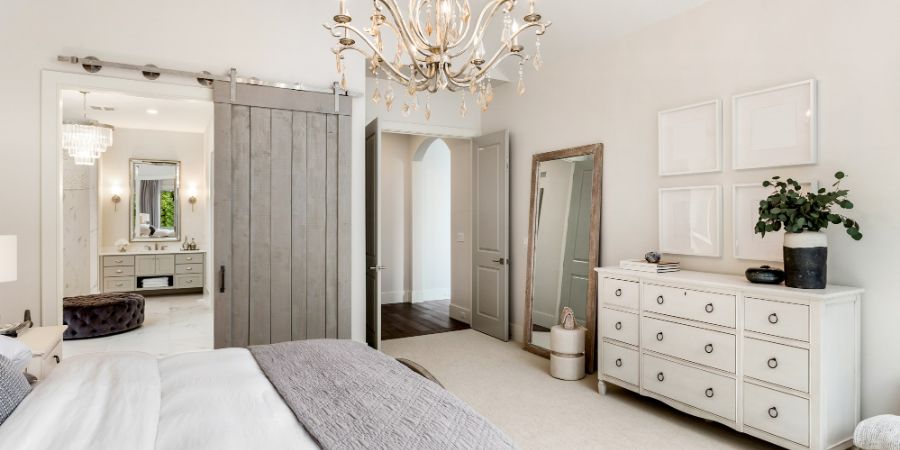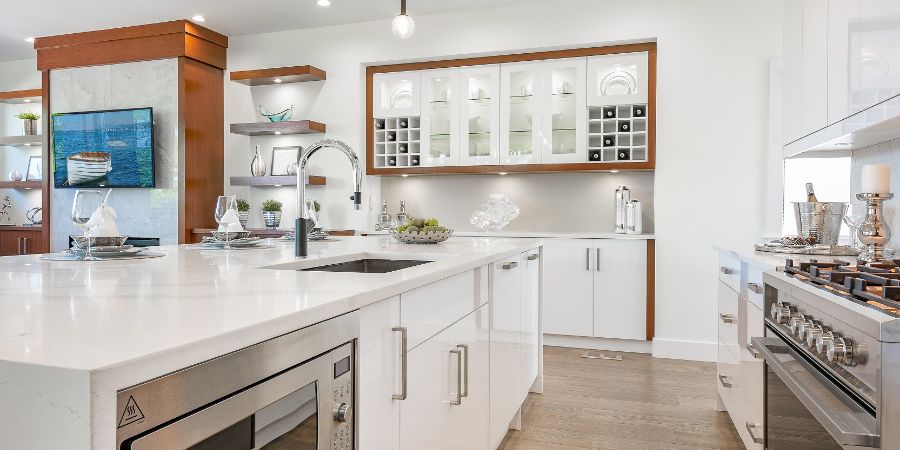Fact: There are many misconceptions about what it takes to work as an interior decorator. For example, some people think that you have to be wealthy to afford all the necessary supplies. Others believe that you need to have a degree in design in order to call yourself an interior decorator. In this article, we’ll debunk 10 of the most common myths about being an interior decorator.
Our goal is that by the time you’re finished reading, you’ll have a much better understanding of what the job entails. From there, you can decide whether or not it’s the right career for you!
PRO TIP: Discover how to become an interior decorator in just 6 easy steps (even if you have NO prior experience) with this Ultimate Guide!
Myth #1: Interior decorators and interior designers are basically the same thing.
Wrong! While both professions deal with the design and decoration of indoor spaces, there are some key differences between the two.
Interior designers typically have more formal training, such as a 4-year degree in interior design. They may also be certified by the National Council for Interior Design Qualification (NCIDQ). Furthermore, they often work on larger projects such as office buildings or restaurants.
Interior decorators, on the other hand, generally have less formal training. This is because interior decorating is not technically a regulated field. Additionally, they tend to work on smaller projects such as homes or individual rooms.
PRO TIP: Check out this blog post to learn more about the differences between an interior decorator and an interior designer!
Myth #2: You can skip professional training and still be a successful interior decorator.
Yes, it’s true that you don’t technically need a formal education to become an interior decorator. However, professional training is still strongly recommended. In fact, we’d even go as far as to say that by not taking it, you’ll likely be setting your career up for failure!
Why is this?
Taking courses and/or completing a certification program can give you the skills and knowledge you need to be successful in the field. Not to mention, many clients will feel more confident working with an interior decorator who has some sort of professional training.
Basically, you’ll book more clients and make more money if you have some sort of proper training under your belt!
FUN FACT: QC Design School‘s self-paced, online Interior Decorating Course can provide YOU with a globally-recognized International Design and Decorating Professional (IDDP) certification in as little as 12 short weeks!

Myth #3: Anyone can be an interior decorator.
While it’s true that you don’t need a formal education to become an interior decorator, not just anyone can do it. This is because being an interior decorator requires a specific skill set.
For example, you need to have an eye for detail and be able to visualize how a space will look once it’s complete. If you’re not good at envisioning the end result, then this is definitely not the career for you!
You also need to have strong communication skills. This is because you’ll be working closely with clients to figure out their needs and wants. If you’re not good at communicating, it’ll be very difficult to understand what your clients are looking for.
Myth #4: You need a lot of money to get started in the field.
This is a common misconception because people assume that you need to have all the necessary supplies and materials to get started. However, this couldn’t be further from the truth!
In reality, you don’t need much money at all to start your interior decorating business. In fact, all you really need is a laptop, a printer, and a good internet connection. With these basics, you can start promoting your business online and booking clients!
PRO TIP: That said, starting your very own interior decorating business will require at least a little bit of money. Find out how much it costs to start an interior decorating business so you can be prepared!
Myth #5: You need to be creative to be an interior decorator.
While being creative is definitely a plus, it’s not a requirement for the job. This is because there are many aspects of the job that don’t require any creativity whatsoever.
For example, keeping track of budget, communicating with clients, and marketing your business are all important parts of being an interior decorator. But none of these tasks require any artistic creativity whatsoever!
Myth #6: You need a lot of experience to be an interior decorator.
This is another common misconception because people assume that interior decorating is a complicated field. However, this couldn’t be further from the truth!
In reality, you don’t need any experience whatsoever to start your own interior decorating business. In fact, many new businesses are started by people who have no experience in the field whatsoever!
All you really need is a willingness to learn and the drive to be successful. If you have these two qualities, then you’ll do just fine!
PRO TIP: Of course, getting experience eventually will be critical to your success. So, here are 17 ways to find clients as an interior decorator!

Myth #7: Being an interior decorator means having to be good at drawing.
This is yet another common misconception because people assume that you need to be able to draw in order to be an interior decorator. However, this couldn’t be further from the truth!
In reality, you don’t need to be good at drawing to be an interior decorator. In fact, there are many successful interior decorators are not good at drawing whatsoever. These days, most of the work is done digitally. This means that you can create designs using computer software without ever having to pick up a pencil!
All you really need is a willingness to learn and the drive to be successful. If you have these two qualities, then you’ll do just fine!
PRO TIP: These 28 apps/software will be able to help you in your interior decorating journey!
Myth #8: You need to be good at math to be an interior decorator.
This is another common misconception because people assume that interior decorating is a complicated field. However, this isn’t necessarily always the case!
In reality, you don’t need to be a math wizard to be an interior decorator. The truth is, you can be just as successful by only having a grasp on the basics.
For instance, you will need to understand how to keep track of a budget – and being able to stick to it. This is an important part of the job because you’ll be working with clients who have a specific budget in mind.
Additionally, you’ll also need to know how to calculate simple measurements in order to draw up a floor plan. But again, this can be done with a basic understanding of math (as well as floor plan-creating software).
You don’t need to be a genius at math in order to forge a thriving career as an interior decorator!
Myth #9: Interior decorators only work with wealthy clients.
This is yet another common misconception about the interior decorating industry. People assume that all interior decorators only work with wealthy clients who have a lot of money to spend.
While it’s true that some interior decorators do work exclusively with wealthy clients, this isn’t always the case. In fact, many interior decorators work with a wide variety of clients, regardless of their budget.
The bottom line is that you can be successful as an interior decorator no matter who your clients are!
Myth #10: Interior decorating is a dying field.
This is the final myth on our list and it’s definitely one of the most ridiculous ones. People assume that interior decorating is a dying field because it’s “not a real job.”
However, this is a boldfaced lie!
Interior decorating is actually a BOOMING industry – and it shows no signs of slowing down anytime soon! In fact, the demand for interior decorators is only increasing as more and more people are looking to improve their homes.
According to Business Wire, the global market for interior design and decorating services is expected to reach a whopping $255.4 BILLION in value by 2027. Between 2020 and 2027, this will work out to be a compound annual growth rate (CAGR) of approx. 7.8%!

5 Interior Decorator Myths That Are Actually TRUE
Now that we’ve debunked some of the most common myths about being an interior decorator, it’s time to set the record straight on some of the myths that are actually true!
Fact #1: Interior decorators are expensive to hire.
This is one myth about interior decorators that actually has some truth to it. While there are many interior decorators who are very affordable, there are also those who charge high rates – especially if they’re experienced or well-known in the industry.
The average cost of hiring an interior decorator is $50-$200 per hour. However, some may charge as much as $500 per hour!
On the flipside, if you’re interested in being an interior decorator, this means you’ll be making amazing money!
Pro Tip: Learn how to set your interior decorating rates properly so you can make killer profits for your business!
Fact #2: Interior decorators need business training/understanding.
This is another myth about interior decorators that is actually true!
While you don’t need a business degree to become an interior decorator, it definitely helps to have some sort of business understanding. This is because being an interior decorator is essentially running your own business.
You’ll need to be good at marketing, sales, and networking in order to find clients and grow your business. Additionally, you’ll need to have some business acumen in order to understand things like profit margins, pricing, and budgeting.
Never launched a business before, or taken any sort of business training? Consider this yet another reason to take an interior decorating certification course!
The right program will also include some component of business training as part of your curriculum. QC Design School’s online Interior Decorating Course, for example, has a whole unit devoted to this topic!
Fact #3: There’s a lot that needs to go into every single interior decorating project.
This is definitely one of the most common misconceptions about being an interior decorator! People assume that all you have to do is pick out some furniture and call it a day.
However, there’s actually a lot more that goes into being an interior decorator than meets the eye. For every single client project, an interior decorator will usually be in charge of the following responsibilities:
- Conducting an initial consultation
- Conceptualizing design plans
- Creating a budget
- Selecting furniture, fabrics, materials, decor, and accessories
- Coordinating with tradespeople (e.g. electricians, painters, etc.)
- Managing budgets and timelines
- Installing the final design
- Providing after-care services
Furthermore, if you intend to run your own business, you’ll also have to factor in these additional tasks on the regular, too:
- Marketing and business development
- Bookkeeping and accounting
- Purchasing supplies
- Hiring and managing employees
- Creating proposals and contracts, etc.
As you can see, there’s a LOT that needs to be done in order for an interior decorating project to come together successfully!
Fact #4: Interior decorating is a very competitive field.
This is another one of the most common myths about being an interior decorator that actually turns out to be 100% true.
While there are many interior decorators out there, the reality is that only a small percentage of them are actually successful. In order to make it in this industry, you’ll need to be able to stand out from the rest and show your clients that you’re the best possible person for the job.
Tips For Standing Out
One way to do this is by putting together a strong portfolio that reflects your best work. Make sure to include a mix of both residential and commercial projects, as well as a variety of different design styles.
Next, ensure that you have a strong online presence. So, make sure you have a polished website and active social media accounts that showcase your work in the best light possible. And that portfolio we just mentioned? Include it within your online presence whenever possible!
From there, it’s also a good idea to get involved with local networking groups – as well as online ones – and to make sure you’re always putting your best foot forward.
Last but not least, as we discussed earlier, it’s important to get certified! This will show potential clients that you have the skills and training necessary to help them achieve their desired results.
As your career progresses, keep in mind that the learning process should never stop. Whether that’s taking more courses in the future or simply reading design-related books and articles, always make sure you’re staying up-to-date on the latest trends.

Fact #5: You can become an interior decorator while still in school, working full-time, or as a full-time parent.
In today’s day and age, there are few things you can’t do online – and becoming an interior decorator is one of them!
Whether you’re currently in school, working full-time, or taking care of your family at home, you can still enroll in an Interior Decorating Course and complete it on your own time.
This means that you can study and complete assignments when it’s most convenient for you. And, since the course is self-paced, you won’t have to worry about falling behind or feeling overwhelmed.
For instance, QC Design School’s Interior Decorating Course is self-paced and done entirely online. Starting on the date you enroll, you’ll be given 2 whole years to finish your program. However, during that time, you can use as much or as little of that timeframe as needed!
So, if you’re looking for a career change but don’t think you have the time to commit to a full-time program, becoming an interior decorator may be the perfect solution.
Pro Tip: Are you a busy parent? These 3 need-to-know tips will help you pass your interior decorating course with flying colors!
Misconceptions Of Interior Decorators: Final Thoughts
As you can see, there are quite a few myths about being an interior decorator floating around out there. The good news is that we were able to debunk each and every one of them for you! So, if you’re thinking about becoming an interior decorator, we hope this article has given you the confidence to take that next step.
And don’t forget to enroll with QC Design School for your interior decorating certification training! In as little as 3-6 months, you can add an internationally-recognized certification + designation to your resume… And start your career on the right foot!
Got any questions or comments for us? We’d love to hear from you in the comment section below!
Happy decorating! 🙂
